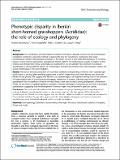Por favor, use este identificador para citar o enlazar a este item:
http://hdl.handle.net/10261/149122COMPARTIR / EXPORTAR:
 SHARE SHARE
 CORE
BASE CORE
BASE
|
|
| Visualizar otros formatos: MARC | Dublin Core | RDF | ORE | MODS | METS | DIDL | DATACITE | |

| Campo DC | Valor | Lengua/Idioma |
|---|---|---|
| dc.contributor.author | García-Navas, Vicente | - |
| dc.contributor.author | Noguerales, Víctor | - |
| dc.contributor.author | Cordero, Pedro J. | - |
| dc.contributor.author | Ortego, Joaquín | - |
| dc.date.accessioned | 2017-05-05T06:10:03Z | - |
| dc.date.available | 2017-05-05T06:10:03Z | - |
| dc.date.issued | 2017-05-04 | - |
| dc.identifier.citation | BMC Evolutionary Biology 17(1): 109 (2017) | - |
| dc.identifier.issn | 1471-2148 | - |
| dc.identifier.uri | http://hdl.handle.net/10261/149122 | - |
| dc.description.abstract | [Background]: The combination of model-based comparative techniques, disparity analyses and ecomorphological correlations constitutes a powerful method to gain insight into the evolutionary mechanisms that shape morphological variation and speciation processes. In this study, we used a time-calibrated phylogeny of 70 Iberian species of short-horned grasshoppers (Acrididae) to test for patterns of morphological disparity in relation to their ecology and phylogenetic history. Specifically, we examined the role of substrate type and level of ecological specialization in driving different aspects of morphological evolution (locomotory traits, chemosensitive organs and cranial morphology) in this recent radiation. | - |
| dc.description.abstract | [Results]: We found a bimodal distribution of locomotory attributes corresponding to the two main substrate type guilds (plant vs. ground); plant-perching species tend to exhibit larger wings and thicker femora than those that remain on the ground. This suggests that life form (i.e., substrate type) is an important driving force in the evolution of morphological traits in short-horned grasshoppers, irrespective of ancestry. Substrate type and ecological specialization had no significant influence on head shape, a trait that showed a strong phylogenetic conservatism. Finally, we also found a marginal significant association between the length of antennae and the level of ecological specialization, suggesting that the development of sensory organs may be favored in specialist species. | - |
| dc.description.abstract | [Conclusions]: Our results provide evidence that even in taxonomic groups showing limited morphological and ecological disparity, natural selection seems to play a more important role than genetic drift in driving the speciation process. Overall, this study suggests that morphostatic radiations should not necessarily be considered as “non-adaptive” and that the speciation process can bind both adaptive divergence mechanisms and neutral speciation processes related with allopatric and/or reproductive isolation. | - |
| dc.description.sponsorship | VGN was supported by a “Juan de la Cierva” fellowship (FPDI-2013-16,828). VN was supported by a FPI PhD studentship (BES-2012-053741). JO was supported by a “Ramón y Cajal” research fellowship (RYC-2013-12,501). This work received financial support from the Spanish Ministry of Economy and Competitiveness (CGL2014-54671-P). We acknowledge support of the publication fee by the CSIC | - |
| dc.description.sponsorship | Open Access Publication Support Initiative through its Unit of Information Resources for Research (URICI). | - |
| dc.publisher | BioMed Central | - |
| dc.relation | info:eu-repo/grantAgreement/MINECO/Plan Estatal de Investigación Científica y Técnica y de Innovación 2013-2016/RYC-2013-12501 | - |
| dc.relation | info:eu-repo/grantAgreement/MINECO/Plan Estatal de Investigación Científica y Técnica y de Innovación 2013-2016/CGL2014-54671-P | - |
| dc.relation | info:eu-repo/grantAgreement/MINECO/Plan Estatal de Investigación Científica y Técnica y de Innovación 2013-2016/FPDI-2013-16828 | - |
| dc.relation.isversionof | Publisher's version | - |
| dc.rights | openAccess | - |
| dc.subject | Ecomorphology | - |
| dc.subject | Geometric morphometrics | - |
| dc.subject | Phenotypic evolution | - |
| dc.subject | Morphostatic radiation | - |
| dc.subject | Orthoptera | - |
| dc.subject | Tempo and mode | - |
| dc.title | Phenotypic disparity in Iberian short-horned grasshoppers (Acrididae): the role of ecology and phylogeny | - |
| dc.type | artículo | - |
| dc.identifier.doi | 10.1186/s12862-017-0954-7 | - |
| dc.description.peerreviewed | Peer reviewed | - |
| dc.relation.publisherversion | http://dx.doi.org/10.1186/s12862-017-0954-7 | - |
| dc.date.updated | 2017-05-05T06:10:04Z | - |
| dc.language.rfc3066 | en | - |
| dc.rights.license | http://creativecommons.org/licenses/by/4.0/ | - |
| dc.contributor.funder | Ministerio de Economía y Competitividad (España) | - |
| dc.contributor.funder | CSIC - Unidad de Recursos de Información Científica para la Investigación (URICI) | - |
| dc.relation.csic | Sí | - |
| dc.identifier.funder | http://dx.doi.org/10.13039/501100003329 | es_ES |
| dc.identifier.pmid | 28472922 | - |
| dc.type.coar | http://purl.org/coar/resource_type/c_6501 | es_ES |
| item.openairecristype | http://purl.org/coar/resource_type/c_18cf | - |
| item.fulltext | With Fulltext | - |
| item.cerifentitytype | Publications | - |
| item.openairetype | artículo | - |
| item.grantfulltext | open | - |
| Aparece en las colecciones: | (IREC) Artículos (EBD) Artículos | |
Ficheros en este ítem:
| Fichero | Descripción | Tamaño | Formato | |
|---|---|---|---|---|
| 12862_2017_Article_954.pdf | 1,67 MB | Adobe PDF |  Visualizar/Abrir |
CORE Recommender
PubMed Central
Citations
1
checked on 06-abr-2024
SCOPUSTM
Citations
7
checked on 16-abr-2024
WEB OF SCIENCETM
Citations
6
checked on 28-feb-2024
Page view(s)
290
checked on 17-abr-2024
Download(s)
271
checked on 17-abr-2024

